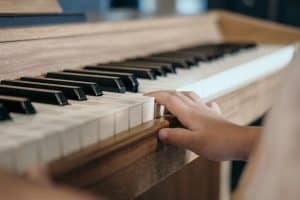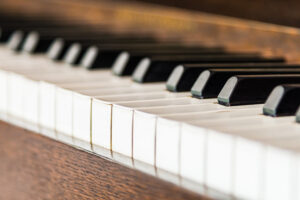The piano is one of the most versatile instruments you can learn. However, understanding piano keys can feel overwhelming for beginners and bring up a lot of questions. How many keys does a piano have? What are the white and black keys called? Whether you’re starting out on your piano journey or just curious, this guide will help you decode the keyboard and set you up for musical success.

What are piano keys?
Piano keys are the black and white keys on the keyboard. They each represent a specific musical note. At first glance, the layout might seem overwhelming, but it’s actually based on a simple repeating pattern that’s easy to learn. This pattern is the key to understanding how melodies, chords, and scales are formed. As you progress, you’ll also encounter key signatures, which tell you which keys on the piano should be played as sharps or flats in a piece of music. These are tied directly to the layout of the piano keys and help shape the mood and character of the music you play. Mastering the keys is your first step towards unlocking the full potential of the piano!
How many keys on a piano?
A standard piano has 88 keys. These keys span seven full octaves plus a few extra notes, giving the piano its remarkable range. Some keyboards may have fewer or more keys with common smaller variants having 44 to 72 keys and some rare larger examples spanning 108 keys!
White keys on a piano
The white keys form the backbone of the piano, representing the natural notes and creating a familiar visual pattern that’s easy to follow. These keys are where most beginners start, as they provide the foundation for scales, chords and melodies.
How many white keys on a piano?
A standard piano has 52 white keys. These represent the natural notes of the musical alphabet: A, B, C, D, E, F, and G. These white keys repeat in a consistent pattern across the keyboard.
What are the white keys on a piano called?
The white keys are called natural notes. They correspond to the notes in the C major scale, which has no sharps or flats.
Black keys on a piano
The black keys on piano add depth and variety to the keyboard, representing the sharps and flats that give music its character and complexity. Their arrangement in groups of twos and threes helps with orientation on the piano.
How many black keys on a piano?
There are 36 black keys on a standard piano. These are grouped in sets of twos and threes, which makes it easier to navigate the keyboard.
What are the black keys on a piano called?
The black keys are called sharps (#) and flats (b), depending on their musical context. For example, the black key between C and D can be called either C# or Db.
What is a piano keys chart?
A piano keys chart is an invaluable tool for beginners as it helps visualise the layout of the keyboard and understand the relationship between individual piano key notes.
Each key is labelled with its corresponding note name, making it much easier to grasp the basics of playing piano scales, chords, and melodies. Keep this image to hand as a reference guide. It’s especially useful for navigating the keyboard while practicing. You’ll notice a repeating pattern of note names across the keyboard, which occurs at both higher and lower pitches. These repetitions are referred to as different octaves, with each octave representing the same set of notes but at a higher or lower pitch. Recognising this pattern is key to understanding how music spans the full range of the piano.

How to identify all keys on a piano
Now we have looked at a smaller let’s look at a few tricks to remembering all the piano notes on the piano key names. The first trick is to learn the patterns of the black and white piano keys. If you look at the keyboard, you will notice there is a repeating pattern of groups of 2 and 3 black keys. You can use this pattern to orient yourself in the piano scales on the keyboard.

The note C is on the outside-left of the group of 2 black keys:
After that, just follow the musical alphabet up the keys until you reach C again, one octave higher! Now you know the names of all the white keys on piano.
Another helpful trick is to label the note names on your keyboard. You can accomplish this with easy to remove tape. Place a small piece of tape on each of the keys and label the letter names with a pen that will not fade. That way the ink won’t come off on your fingers! This is a great trick for beginners to get to know the keyboard layout quickly and efficiently. Once you have your piano keys labeled, you can get rocking on some great tunes. Check out the Skoove app, the perfect place to learn your next piano song.
Different types of piano keys
Keys come in various styles and weights, including weighted, semi-weighted, and unweighted. The weight significantly affects playability. For example, unweighted keys enable unique techniques like finger slides, which are impossible on a hammer-action acoustic piano. Understanding these differences is essential when choosing between a digital piano vs keyboard.
Acoustic Pianos:
- Acoustic pianos use a hammer-action system, where pressing a key triggers a felt-tipped hammer to strike a string. This mechanism creates a distinctive feel known as “action”.
- Pianos with lighter action are easier to play, while heavier action offers more resistance. Despite variations in weight, all acoustic pianos operate on this principle.
Digital Pianos:
- Digital pianos vary in weight and action. Some use hammer-action keys to mimic the feel of acoustic pianos. These models are often more affordable and space-efficient than acoustic pianos.
- Others feature semi-weighted keys, where springs control the action. These keys are lighter and easier to play, making them ideal for beginners but less realistic in feel.
Electric Pianos:
- Many electric pianos have unweighted keys, also called “waterfall” or “synth” keys. These keys require minimal effort to press, making them perfect for young children or players who prioritize speed and versatility.
- Organists and synthesizer players often prefer unweighted keys for fast glissandos and expressive effects.
Understanding these key differences helps you make an informed decision when selecting a piano or keyboard.
How to clean piano keys?
Keeping your piano keys clean ensures they stay in great condition. Here’s a step-by-step guide:
- Dust the keys regularly: Use a soft, dry cloth to remove surface dust.
- Use a mild cleaning solution: Mix a small amount of gentle soap with water. Avoid harsh chemicals.
- Wipe the keys: Dampen a cloth slightly with the solution and gently wipe each key.
- Dry immediately: Use a clean, dry cloth to remove any moisture.
- Disinfect occasionally: If needed, use a diluted alcohol solution (no more than 70%) to sanitise the keys.
💡Pro Tip: Never spray liquid directly onto the keys and avoid excessive moisture.
Learning how to play all of the keys
Mastering the piano keys is the first step to becoming a confident player. Start by familiarising yourself with the basic piano keys using the C major scale, which uses only white keys, then gradually incorporate the piano black keys to explore sharps and flats and other key signatures. Platforms like Skoove make this process interactive and fun, offering guided lessons and practice exercises to help you unlock your full potential.
FAQ
Author of this blog post:
Matthew Dickman

With over a decade of experience in music education Matthew holds a BA in Music from Paul McCartney’s LIPA and an MA in Composition from the University of Salford. Mathew has developed a distinctive compositional voice and approach to music theory education through his research and work in the music industry. Matthew’s writing for Skoove combines experience from orchestral and media composition, and as a gigging jazz musician, to create a wholistic and accessible pedagogy for musicians of any level. Away from music, he enjoys reading and exploring nature to expand his horizons and knowledge contributing to his holistic teaching style.















